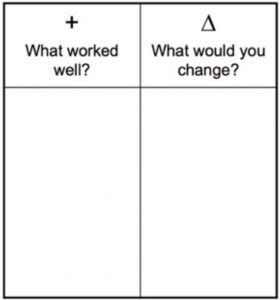 It is common in classes to have students critique other students on their work. Everyone learns by receiving and giving feedback, but neither is easy. While receiving negative feedback is particularly difficult to hear, especially among students, giving feedback can be even harder. It is too easy to respond when asked, “How did I do?” with “You did great. It was good.” How useful is that response to the student? How will the student know what areas of improvement to focus efforts? The plus-delta method provides an easier way to receive and give feedback.
It is common in classes to have students critique other students on their work. Everyone learns by receiving and giving feedback, but neither is easy. While receiving negative feedback is particularly difficult to hear, especially among students, giving feedback can be even harder. It is too easy to respond when asked, “How did I do?” with “You did great. It was good.” How useful is that response to the student? How will the student know what areas of improvement to focus efforts? The plus-delta method provides an easier way to receive and give feedback.
The plus-delta method is a feedback framework that provides a structured approach to assess strengths and weaknesses, allowing for constructive feedback and continuous improvement. The name “plus-delta” refers to two key components of the evaluation: the “plus” represents positive aspects or successes, while the “delta” denotes areas that need improvement or changes. The usage of “delta” comes from the Greek letter delta. It is used in scientific and mathematical applications to denote change.
To use the method, begin by asking for the “plus” points. Focus on the positive aspects or successes of the student’s work. Identify and document the strengths, achievements, and favorable outcomes that were observed. This step acknowledges and celebrates what went well. Be specific: your presentation was well-organized, you spoke clearly, or your small group activity engaged everyone in the experience. These examples clearly identify the specific behaviors and outputs that worked well.
Next, identify the “delta” points. These points are what can be changed to improve future performance. As such, it is necessary that the delta begins with a verb. Instead of saying that the paper wasn’t interesting, identify what can be done to improve the paper: develop your topic sentences into stronger statements, or use active rather than passive voice. Instead of saying you didn’t understand the presentation, identify how it could be made understandable: project your voice to the back of the room, speak to the audience rather than read your notes, or use the full name at least the first time instead of only the acronym. All these suggested changes provide specific actions that could improve future work.
In addition, in using the plus-delta method, students can receive both the plus and the delta remarks more readily since they focus on specific actions, even if the actions are about the person. The plus-delta method also helps the listeners to think critically and to analyze why something was good or did not do well. The plus-delta evaluation method offers a balanced approach to feedback, acknowledging achievements while also highlighting areas for growth. By focusing on both the positives and the areas needing improvement, it promotes a constructive and forward-looking mindset, fostering continuous learning and development.
